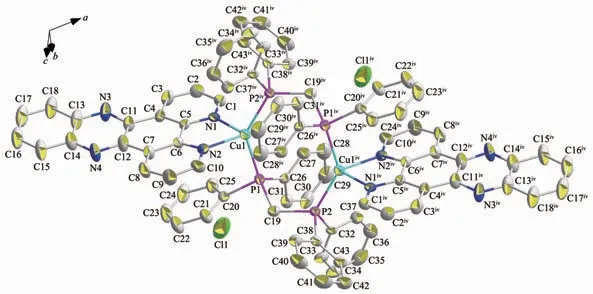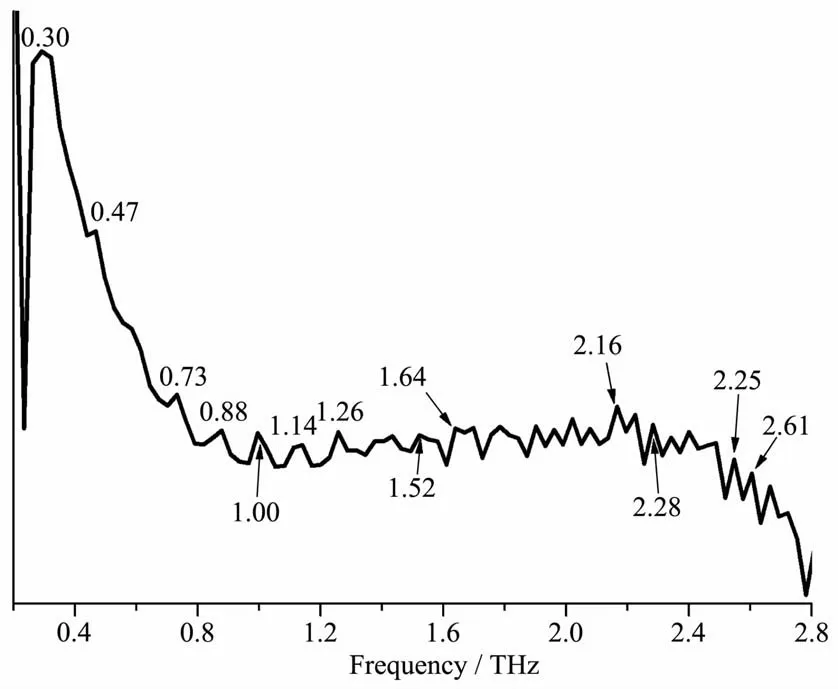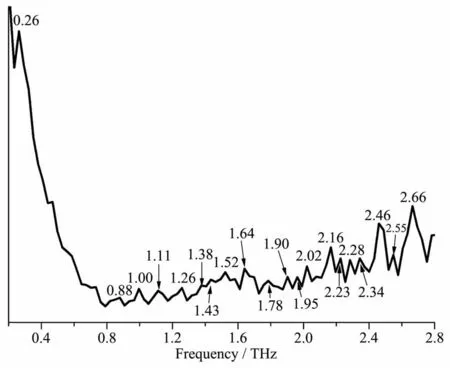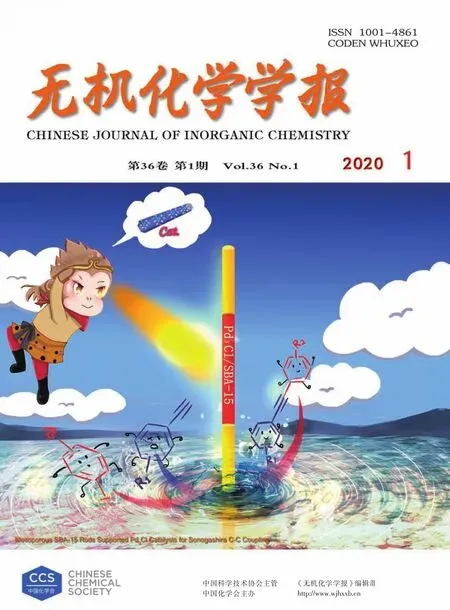两个二亚胺-铜(Ⅰ)-膦配合物的合成、结构和太赫兹时域光谱
朱 宁 潘 迅 林 森 杨玉平 辛秀兰 李中峰 张 帆*, 金琼花*,
(1 首都师范大学化学系,北京 100048)
(2 中国科学院福建物质结构研究所,结构化学国家重点实验室,福州 350002)
(3 中央民族大学理学院,北京 100081)
(4 北京工商大学食品学院,北京 100048)
0 Introduction
The photoluminescence of metal complexes has been widely studied in recent years for their promising potential in optical sensor[1-3],solar energy conversion[4-6],biological systems[7-9]and organic light-emitting diodes(OLEDs)[10-15].Through systematic study on the variation of ligands, structural and bonding modes of different metal centres, the structure-property relationships of various classes of luminescent transitional metal complexes can be obtained. In this respect, Cu (Ⅰ)complexes play an important role in devices that require high quantum efficiency[16-18]. Compared with traditional precious metals like iridium, ruthenium,and so on[19-20], copper is abundant in nature and low in cost. At the same time, different Cu (Ⅰ)salts and special ligands can be adopted around the central copper to control the structure of Cu(Ⅰ)complexes as well as improve their luminous performances[21].
Heteroleptic Cu (Ⅰ)complexes of the [Cu(N^N)(P^P)]+type system have been developed, which can exhibit impressive performance, e.g., long-lived excited-state, high emission quantum yield with tunable emission spectra[22-25]. According to previous literatures, it is obvious to find that steric effects have the strongest impact on luminescent properties, because large and rigid ligands can suppress the flattening distortion for complexes in emissive state[26-29]. Based on this point, dipyrido [3,2-a∶2′,3′-c]phenazine (dppz)was found as a noticeable bidentate N-donor ligand.The bulky aromatic ring can furnish large steric hindrance and sequentially keep the complex in its original tetrahedral geometry. In accordance with the hard and soft acid-base (HSAB) theory, dipyrido[3,2-a∶2′,3′-c]phenazine (dppz) can easily coordinate with Cu(Ⅰ)centre, which proves theoretically that dppz can serve as a resultful ligand to synthesize Cu (Ⅰ)complexes.
In this paper, two novel Cu (Ⅰ)complexes with dppz ligands have been reported. According to preexisting literatures and former researches in our group[30-32], the introducion of phosphine ligands can improve the luminescent property and enhance the stability of Cu (Ⅰ)complexes. On the basis of these results, we added triphenylphosphine (PPh3) and bis(diphenylphosphino)methane (dppm) as phosphine ligands to the system and synthesized two heteroleptic Cu(Ⅰ) complexes, [Cu(PPh3)2(dppz)]I (1) and [Cu2(dppm)2(dppz)2]Cl2(2). We also used X-ray diffraction,elemental analysis,1H/31P NMR spectroscopy, fluorescence spectra and THz time-domain spectroscopy(THz-TDS)[30,33]to characterize their structures and investigated the emission and fluorescence properties.
1 Experimental
1.1 Materials and measurements
All commercially available starting reagents were used without any purification. FT-IR spectra (KBr pellets) were measured on a Perkin-Elmer Infrared spectrometer. C, H and N elemental analysis were carried out on an Elementar Vario MICRO CUBE(Germany) elemental analyzer. Room-temperature fluorescence spectra were measured on F-4500 FL Spectrophotometer.1H NMR was recorded at room temperature with a Bruker DPX 600 spectrometer.The THz absorption spectra were recorded on a THz time domain device of Minzu University of China,carried out in a N2atmosphere to avoid the influence of water vapor, based on photoconductive switches for the generation and electro-optical crystal detection of the far-infrared light, effective frequency in the range 0.2~2.8 THz.
1.2 Synthesis of [Cu(PPh3)2(dppz)]I (1)
A mixture of CuI (0.038 1 g, 0.2 mmol), dppz(0.056 4 g, 0.2 mmol) and PPh3(0.104 9 g, 0.4 mmol)were dissolved in the mixed solvents of 5 mL CH2Cl2and 5 mL CH3OH. The mixture was stirred for 6 hours and filtered. Yellow crystal 1 was obtained from the filtrate after standing at room temperature for several days. Yield: 75%. Element analysis Calcd. for C54H40CuIN4P2(%): C, 65.03; H, 4.03; N, 5.62. Found(%): C,64.98; H, 3.98; N, 5.77. IR data (cm-1, KBr pellets):3 434w,3 053w,1 630w,1 572s,1 488s,1 435s,1 414 m, 1 357m, 1 337s, 1 071m, 819s, 736m, 695w, 523w.1H NMR (600 MHz, DMSO-d6, 298 K): δ 9.65 (m, CH from dppz),9.02(dd,CH from dppz),8.47(dd,CH from dppz), 8.15 (dd, CH from dppz), 8.05 (dd, CH from dppz),7.38(m,CHbenzenefrom PPh3),7.31(d,CHbenzenefrom PPh3),7.21 (d, CHbenzenefrom PPh3);31P NMR (243 MHz,DMSO-d6, 298K): δ -1.31 (s, phosphorus from PPh3).
1.3 Synthesis of [Cu2(dppm)2(dppz)2]Cl2 (2)
Complex 2 was prepared in a manner similar to the described for 1, using CuCl (0.019 8 g, 0.2 mmol),dppz(0.056 4 g, 0.2 mmol) and dppm (0.076 9 g, 0.2 mmol) as starting materials in a mixture of CH2Cl2(5 mL)and CH3OH (5 mL).Yield:55%.Element analysis Calcd. for C68H64Cu2Cl2N8P4(%): C, 62.01; H, 4.85; N,8.53. Found(%): C, 62.05; H, 4.87; N, 8.52. IR data(cm-1, KBr pellets): 3 426w, 3 049w, 1 630w, 1 573w,1 488s,1 434m,1 416s,1 432s,1 358m,1 338m,1 074 m,824m,738m,694m,515s,480s.1H NMR(600 MHz,DMSO-d6,298K):δ 9.55(d,CH from dppz),9.17(s,CH from dppz), 8.40 (s, CH from dppz), 8.08 (s, CH from dppz), 7.98 (s, CH from dppz), 7.43 (m, CHbenzenefrom PPh3),7.16(m,CHbenzenefrom PPh3),7.04(s,CHbenzenefrom PPh3);31P NMR (243 MHz, DMSO-d6, 298K): δ -1.18(s, phosphorus from dppm).
1.4 Structure determination
Single crystals of the title complexes were mounted on a Bruker Smart 1000 CCD diffractometer equipped with a graphite-monochromated Mo Kα (λ=0.071 073 nm) radiation at 298 K. Semi-empirical absorption corrections were applied using SADABS programs[34]. All the structures were solved by direct methods using SHELXS program of the SHELXTL-97 package and refined with SHELXL-97[35]. Metal atom centers were located from the E-maps and other nonhydrogen atoms were located in successive difference Fourier syntheses. The final refinements were performed by full matrix least-squares methods with anisotropic thermal parameters for non-hydrogen atoms on F2. The hydrogen atoms were generated geometrically and refined with displacement parameters riding on the concerned atoms.
Crystallographic data and experimental details for structural analysis are summarized in Table 1, and selected bond lengths and angles of complexes 1 ~2 are summarized in Table 2.
CCDC: 1558489, 1; 1915009, 2.

Table 1 Crystallographic data for complexes 1~2

Continued Table 1

Table 2 Selected bond distances (nm) and bond angles (°) for complexes 1~2
2 Results and discussion
2.1 Synthesis of the complexes
Both complexes were synthesized using the same N-heteroaromatic ligands dipyrido [3,2-a∶2′,3′-c]phenazine(dppz)and different phosphine ligands by one-pot reaction. The previous literatures[28]show that solvents have non-negligible impact on the terminal structure of complexes. Thus, we chose mixed solvent of CH3OH and CH2Cl2(1∶1,V/V)and added triphenylphosphine in the synthesis of complex 1 (Scheme 2). Complex 2 was prepared in a similar manner as described for 1,except that bis (diphenylphosphino)methane was used in place of triphenylphosphine. Complexes 1 and 2 are mononuclear and dinuclear structures, respectively.Both of them are stable in air and can be stored for a long term.

Scheme 1 Structures of the ligands used in the present work

Scheme 2 Routes of syntheses for complexes 1 and 2
2.2 Description of crystal structures
Fig.1 shows the molecular structure of complex 1.X-ray analysis clearly reveals that 1 crystallizes in the triclinic crystal system with space group P1 and adopts a typical mononuclear tetrahedral coordination geometry for Cu(Ⅰ)ion, where Cu(Ⅰ)is surrounded by two P atoms from triphenylphosphine (PPh3) ligands and two N atoms from dipyrido[3,2-a∶2′,3′-c]phenazine(dppz) ligand. The Cu-N bond lengths range from 0.211 3(5)to 0.214 0(4)nm and Cu-P from 0.229 83(17)to 0.230 09(17) nm, which are slightly different from those of [Cu(PPh3)2(DPPZ)]BF4[36](Cu-N bond lengths range from 0.206 9 to 0.210 5 nm and Cu-P from 0.227 2 to 0.227 5 nm) and [Cu(PPh3)2(dppz)]NO3[37](The average bond lengths of Cu-N and Cu-P are 0.209 6 and 0.227 2 nm, respectively). This difference may be due to the replacement between CuBF4/CuNO3and CuI. The bond angles were listed in Table 2,which means that Cu(Ⅰ) ion occupies a distorted tetrahedral coordination center.
According to previous literatures[36-37], Cu(Ⅰ)complexes with large coplanar conjugation planes, such as the inter- or intra-molecular π-π stacking, can contribute to a formation of complex molecules in solid state, showing a head-to-head dual-molecule structure.Besides, π-π stacking possibly stabilizes and protects the excited state of Cu(Ⅰ)complexes from being attacked by external molecule and suppresses the probability of quenching[38]. However, similar to the complex[Cu(PPh3)2(dppz)]BF4, no such π-π stacking or headto-head dual-molecule structure was found in solid state [Cu(PPh3)2(dppz)]I. This left the copper exposed and vulnerable to attack by peripheral molecules,increasing the possibility of quenching.
The crystal packing of complex 1 reveals that unit cell forms two-dimensional supramolecular networks as depicted in Fig.2. The above 2D structure is supported by C-H…π interactions (C16…Cg(1)0.270 nm; C29…Cg(2) 0.291 nm; C39…Cg(3) 0.259 nm) between neighboring molecules, which play a critical role in structure orientation.

Fig.1 Molecular structure of complex 1
Complex 2 crystallizes in the monoclinic crystal system with space group C2/c and its molecular structure is depicted in Fig.3. It consists of a neutral dimeric molecular unit with two copper atoms bridged by a pair of dppm ligands and forms an eight-membered Cu2P4C2ring. Besides, each Cu (Ⅰ)centre terminally chelates with two nitrogen atoms of dppz. The Cu-P bond lengths ranging from 0.222 9 to 0.226 23 nm are similar to those of normal [Cu(dppm)(P^P)]+complexes[39]. The Cu…Cu separation of 0.365 2 nm is significantly longer than the range of copper-copper bond length, suggesting that copper atoms in complex 2 are not involved in metal-metal bonding interactions.The P(1)-Cu(1)-P(2)angle(104.95(4)°)is similar to the corresponding complex [Cu(dppm)(MeCN)2]2(ClO4)2[40].In summary, Cu(Ⅰ)in complex 2 is a similar distorted tetrahedral coordination centre as 1, and only the presence of bridging ligand (dppm) results in the formation of a binuclear complex.

Fig.2 Two-dimensional networks of complex 1

Fig.3 Molecular structure of complex 2
2.3 1H NMR and 31P NMR spectroscopy
The1H NMR spectra of complexes 1 and 2 were measured at room temperature in DMSO-d6. The1H NMR spectrum of complex 1 exhibited signals(multiple peaks) between 9.65 and 8.05 (δ), which can be assigned to protons from the aromatic rings of dppz ligand ((δ: 9.65, 2H, dd, J=8.1Hz), (δ: 9.02, 2H, dd,J1=8.1 Hz, J2=1.5 Hz), (δ: 8.47, 2H, dd, J1=6.5 Hz, J2=3.4 Hz), (δ: 8.15, 2H, dd, J1=6.6 Hz, J2=3.3 Hz), (δ:8.05, 2H, dd, J1=8.1 Hz, J2=4.8 Hz)). In complex 1,the signals at a δ range of 7.38~7.21 are attributed to protons from PPh3((δ: 7.38, 6H, m), (δ: 7.31, 12H, d),(δ: 7.21, 12H, d)), respectively. As for complex 2, the signals at a δ range of 9.65~7.98 belong to heterocyclic hydrogen from dppz((δ:9.55,4H,d,J=7.8 Hz),(δ:9.17,4H, s), (δ: 8.40, 4H, s), (δ: 8.08, 4H, s), (δ: 7.98, 4H,s)) and dppm ((δ: 7.43, 8H, m), (δ: 7.16, 16H, m), (δ:7.04~6.99, 16H, t)), respectively. While the31P NMR spectra of complexes 1 and 2 exhibit single signals at-1.31 and -1.18 (δ) can be ascribed to phosphorus of the diphosphine ligands, respectively.
2.4 Fluorescence spectra
Fig.4 presents the solid-state emission spectra of complexes 1 and 2 which were measured at room temperature. Upon excitation at 408 nm, complex 1 displayed emission at 612 nm with a broad band peak. Compared with [Cu(PPh3)2(dppz)]BF4[37], it stays slightly blue-shifted about 17 nm in the short wave direction, which may result from the I-replacing BF4-.In comparison with 1, complex 2 exhibited weak solidstate emission centered at 604 nm under excitation at 402 nm, which red-shifts 8 nm compared to 1. For the same ligands in complexes 1 and 2, it is observed that the enlarged conjugation plane in dppz has an important influence on Cu(Ⅰ)complexes. On the one hand, the large steric hindrance can suppress the flattening in tetrahedral structure; on the other hand,the enlarged conjugation increases the delocalization of electrons on the ligand, which will decrease the quantum yields and destroy the luminescent performance. Compared with the corresponding ligands, all of complexes show strong red-shifted of emission maximum, which may be attributed to metal-to-ligand charge transfer luminescent emission between the central Cu(Ⅰ)and ligands.

Fig.4 Luminescent spectra of complexes 1 and 2 in the solid state at 298 K
2.5 Terahertz time domain spectroscopy (THz-TDS)
The terahertz time-domain spectroscopy (THz-TDS) of PPh3, dppm, dppz and complexes 1~2 were measured in a range of 0.2 ~2.8 THz at room temperature. All the above compounds had characteristic resonance peaks, which may be explained by the fact that in polar molecules the dipoles rotate and vibrate,resulting in strong absorption and chromatic dispersion.The peaks found for them were as follows: PPh3: 0.26,1.00, 1.25, 1.32, 1.70, 1.90, 2.02, 2.29, 2.49, 2.64 THz (Fig.5); dppm: 0.47, 0.73, 0.88, 1.00, 1.14, 1.26,1.52, 1.64, 2.16, 2.28, 2.55, 2.61 THz (Fig.6); dppz:0.26, 0.88, 1.00, 1.26, 1.38, 1.43, 1.52, 1.64, 1.78,1.90, 1.95, 2.02, 2.16, 2.23, 2.28, 2.34, 2.46, 2.55,2.66 THz (Fig.7); complex 1: 0.26, 0.74, 0.86, 1.02,1.43, 1.58, 1.74, 1.87, 1.93, 2.08, 2.20, 2.28, 2.52,2.63, 2.69, 2.78 THz (Fig.8); complex 2: 0.23, 0.34,0.42, 1.45, 1.75, 1.93, 2.03, 2.17, 2.29, 2.36, 2.48,2.69 THz (Fig.9). The phosphine ligands PPh3and dppm are non-polar molecules, and the weak peaks appearing in the terahertz time-domain spectra are attributed to the tiny skeleton vibration of the unit cell as a whole. The absorption peaks present in dppz are attributed to π … π stacking existing between conjugate planes. By comparing the THz absorption spectra of the products with those of the reactants,some phenomena can be found that most peaks of the ligands disappeared or moved in the complexes. New peaks appearing in the complexes indicate that the THz absorption spectra are associated with the coordination of copper ions and the ligands. According to the previous study of our group, the absorption peaks of complex 1 at 1.43~2.52 THz are related to the C-H…π intermolecular weak force. There are big differences in THz absorption spectra of complexes 1 and 2 because of the effect of different coordinating phosphine ligands and terminal geometry structures.Although the correspondence between the crystal structures and observed spectra does not allow a definitive characterization, it is possible to make tentative assignments of many of the observed features in the terahertz region for the samples. The results in this work are a supplement to the THz spectroscopic properties of Cu(Ⅰ)complexes containing nitrogen and phosphorous ligand.

Fig.5 Terahertz spectrum of PPh3 in a range of 0.2~2.8 THz

Fig.6 Terahertz spectrum of dppm in a range of 0.2~2.8 THz

Fig.7 Terahertz spectrum of dppz in a range of 0.2~2.8 THz

Fig.8 Terahertz spectrum of complex 1 in a range of 0.2~2.8 THz

Fig.9 Terahertz spectrum of complex 2 in a range of 0.2~2.8 THz
3 Conclusions
Two novel Cu(Ⅰ)complexes, namely [Cu(PPh3)2(dppz)]I (1) and [Cu2(dppm)2(dppz)2]Cl2(2), have been synthesized and characterized by single-crystal X-ray diffraction, elemental analysis,1H/31P NMR spectroscopy, fluorescence spectra and THz time-domain spectroscopy (THz-TDS). 1 is a mononuclear complex and 2 is a dinuclear complex because of its bridging phosphine ligands. Both of their emission peaks are derived from metal-to-ligand charge transfer (MLCT).All the complexes show great stability, which can be used in optical materials and luminescence research.The application of THz time domain spectroscopy(THz-TDS) provides useful information for researching the structure and luminescence of compounds.

